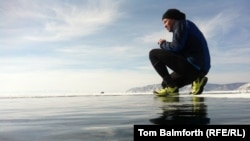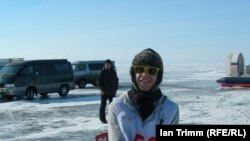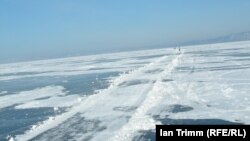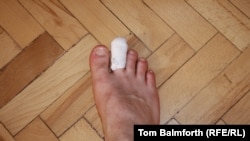It’s 9 a.m. on a winter’s morning in the resort village of Listvyanka and about 140 runners clad in balaclavas, leggings, gaiters, sunglasses, and grip-shod trainers are huddled in buses waiting to run, skid, and hobble a marathon across Siberia’s frozen Lake Baikal. Over 100 are running the full distance -- 42.2 kilometers across the deepest lake on the planet from the western shore in Irkutsk Oblast to the Buddhist Republic of Buryatia on the far side. Half marathoners stop after 21 kilometers about 1.5 kilometers above the lakebed.
At first runners get out to take photos, but hop back into the warmth of the bus to shelter from the minus 11 degree Celsius cold. The bus is a bit too hot as well and everyone is keen to get started. We’re being held longer than expected before the race: organizers are apparently checking the volatility of kilometer-long cracks that periodically erupt through the icy surface due to underwater currents, the changing seasons, and intense seismic activity. The lake itself is situated on a geological rift and was created by earthquakes millions of years ago. It is one of the most ancient lakes in the world, protected by UNESCO, and holds about one-fifth of the world’s fresh water.
On a clear day you can easily see the far embankment, but today it is shrouded by a thin haze that later evaporated after the sun rose above the snowy mountains encircling the lake.
Stories are going around about a fog that descended on the race two years ago, causing some participants to get lost and briefly veer off-piste. Then there’s local running legend Sergei Kalashnikov from the regional capital Irkutsk who dashed across in 2 hours 53 minutes -- the fastest time recorded in the 40 years since the run was apparently first attempted.
But local ice jogging aficionados claim the true record-holder is a man called Yura who recorded a slower time, but ran across the lake as it lies -- without the route flattened and marked out in order to make it easier to run. This year’s is the ninth official race and the winding trail that skirts unstable areas and ruptures in the ice is marked out by knee-high red flags. The event is meant to support the preservation of Lake Baikal’s pristine waters -- an issue that spurred civil-society activism during perestroika.
09:45: Some runners take part in a ritual to appease the Baikal spirit -- an amorphous Siberian version of the Loch Ness monster -- by sprinkling and drinking milk on the lake. The event's website had mentioned a vodka-sprinkling ritual that included knocking back a shot of Russia’s other favorite spirit before the run so the milk comes as a relief. Kalashnikov is taking part today. He’s in the “no. 1” shirt. Many runners are foreign and the French, Germans, Japanese, Americans, and British are particularly well represented.
09:55: Finally, we’re off. I’m carrying a niggle in my left leg so I stay behind the initial charge of runners so I don’t slip over or pull anything. I’ve never run more than 28 kilometers so my aim is just to finish the race. After training in Moscow parks through winter, at times knee-deep in snow, the sensation of running in subzero temperatures is not new, but it is very slippery under foot. It’s slow-going, but I don’t have to alter my gait too much.
To start with, the surface is mirror-smooth ice with almost no snow cover whatsoever. Nearly all runners are wearing crampon-style grips like Yak Trax that slip over their trainers. The black ice is so clear you can see straight through it and follow the white cleaves that appear to run meters into the depths below. The ice is well over 1 meter thick and cars, minibuses, and hovercrafts are stationed at the starting flagpoles. In places the ice is so transparent, it’s almost vertigo inducing -- like running on a skylight above a deep, dark drop. A couple of Brits perform Jurgen Klinsmann-style dives for photographers and slide several meters on their bellies along the ice.
10:30: The sun finally rises over the mountain. The forecast predicted the temperature would rise to 8 below by midday. It’s quickly becoming bright and is getting warmer. The sunglasses and sun block are already paying off. It seems we’ve been lucky with the weather conditions: when we arrived two days earlier, the wind was howling so fiercely that a babushka at the bus station warned us with comic gravity that we’d certainly perish if we attempted the run.
Now I feel overdressed in thick gloves, a grey hoodie, two T-shirts, leggings, shorts, an “ushanka” (Russian fur hat with ear flaps), and fake yellow Ray-Bans that a Frenchman lent me before the race. Already the runners are spread out over a long distance. I can make out a trail of tiny black figures tapering off into the distance against the white. It’s silent on the lake apart from the crunch of grips on ice, although I’m keeping an ear out for any pops and creaks from the ice as the current-swirling waters surge up from beneath and the lake tries to breathe out.
10:45: Arrive at the first food station: dried fruits, walnuts, chewy sweets, steaming sugary tea, and water. It’s the 8-kilometer mark. The complexion of the ice is becoming rougher -- there are bobbles on the surface like big bubbles that have risen up and frozen mid pop. It’s slightly easier to grip although you can already feel the impact of the ice on the joints. It’s more uneven and there’s more snow cover than before. I’m later told this long stretch of ice made the course slower to run on than in some previous years.
11:30: I’m pretty hot by now. The sun feels strong and my sun lotion is running down my face with the sweat. Think I might have to get rid of the hat at some point. I dimly recall someone telling me that Lake Baikal gets more sun in a year than places in southern Italy. The sky is entirely clear now. Both shores are visible. There is less and less ice on the surface and it is snowier under foot.
12:03: Delighted and surprised (because of the leg injury) to make it to the 21-kilometer, half-way mark. I stop off for a minute or so and slug three cups of warm sugary tea and pocket some dried apricots for later. A few finished half-marathoners are encouraging the remaining runners. There’s a portable toilet, cars, snow-buggies, hovercrafts, a small tent, and another food station. The surface is now almost entirely compacted snow, which is easier to run on quickly, but is still unnerving since it is uneven.
12:25: The distances between groups of runners is widening significantly now. A huge rumble sounds from somewhere ahead and the ice palpably shudders under foot. For a moment I thought it was an avalanche coming out of the mountains ahead of us. The sound echoes off the mountains. It turned out to be a huge crack breaking out in the ice and one runner later told me the tremors knocked him off balance.
27 kilometers: We get to a food station where I load up on tea and walnuts and more dried apricots. I hand over my sweat-drenched hat to a marshal standing by. She kindly promises to bring it back to the hotel starting point. A little further on a solitary bored-looking official sitting on a snow buggy by the side of the track jokingly offers to drive me to the finish line.
We hit the 32-kilometer mark, the wind is picking up, and I'm beginning to regret getting rid of the hat. My hair has partly frozen. It’s definitely got a touch colder, although it’s not too bad. It’s still a beautifully clear day.
I’m chatting to Andrei, a marathon runner from Arkhangelsk in northern European Russia. He says he’s part of a small jogging club up there, but whenever they go out jogging they get funny looks from passersby. It sounds like fitness-paranoid jogging culture has caught on less up there even than it has in Moscow where babushkas are horrified to see people running in shorts in the middle of winter.
Andrei gleefully tells me that the marathon really begins at the 32-kilometer mark -- apparently a well-known fact to anyone who has attempted a marathon before. My stomach feels awful suddenly -- I assume it’s the sugar and liquid churning around inside. My legs are getting really heavy and the intermittently more churned-up parts of snow on the track force runners to slow down for fear of losing balance or turning an ankle.
I haven’t hit the fabled “wall,” but my legs hurt in all my joints and it feels like a couple of toenails may have become detached. I can see a distance signpost coming up which I think should say 40 kilometers, but as I get closer it says only 39.
15:42: Finally I make it to the other shore and there is a maybe-200-meter (it’s impossible to judge by this stage) home straight parallel with the embankment. For a rare moment during this marathon, runners are cheered on by spectators, marshals, and fellow runners waiting at the finish line.
… And, I finish. There’s a small heated tent pitched on ice at the end where they’re serving Russian “pelmeni” dumplings. A medley of hyperactive, pale, exhausted, and sweaty runners are sitting on benches inside. Sergei Kalashnikov from Irkutsk has won again, although he recorded a slower time of around 3:07. Apparently the British Embassy defense attache lost to the German defense attache in the half marathon.
We are held at the end of the marathon for almost an hour before we are shuttled back on buses. Some have to wait longer. Aleksei, the head organizer, says that seismic activity made this ninth marathon across Baikal the “hardest yet” to organize for safety reasons. The Emergency Situations Ministry services have been involved and I get the impression they haven’t skimped anywhere on safety measures.
I go to pick up my coat and phone. Each participant was handed a plastic bag at the start line for personal belongings that organizers promised to bring to the finish line. I find, to my dismay, that my phone is not there. Apparently this has never happened before, although one other Japanese party has lost something too. Aleksei, the organizer, is clearly upset that this has happened and suggests they have fallen out of the bags and that they’d turn up. They still haven’t five days later.
It’s a serious annoyance, but the euphoria of finishing the event is stronger. Perhaps I shouldn't have spurned the milk/vodka-sprinkling ritual at the start and perhaps losing the phone was the pay-off to the Baikal spirit for allowing me to complete the race with an injury.
My leg niggle has not even vaguely twinged since the marathon. Apparently 42.2 kilometers of ice jogging has therapeutic aspects to it. I’d almost pulled out of the race at the last minute after the pain of attempting a short practice run on the ice the day before. My toenails, however, were not so lucky. They hadn’t ripped off as I’d imagined during the race, but they had shriveled up, gone black, died, and risen up on blood blisters that are best not described.
I went to see a doctor about an allergic reaction I had in Listvyanka and ended up having a series of injections for the allergy, followed by an impromptu operation to remove one of my right toenails. A week later, I’m still hobbling and even pulling my shoe on is an effort.
At first runners get out to take photos, but hop back into the warmth of the bus to shelter from the minus 11 degree Celsius cold. The bus is a bit too hot as well and everyone is keen to get started. We’re being held longer than expected before the race: organizers are apparently checking the volatility of kilometer-long cracks that periodically erupt through the icy surface due to underwater currents, the changing seasons, and intense seismic activity. The lake itself is situated on a geological rift and was created by earthquakes millions of years ago. It is one of the most ancient lakes in the world, protected by UNESCO, and holds about one-fifth of the world’s fresh water.
On a clear day you can easily see the far embankment, but today it is shrouded by a thin haze that later evaporated after the sun rose above the snowy mountains encircling the lake.
Stories are going around about a fog that descended on the race two years ago, causing some participants to get lost and briefly veer off-piste. Then there’s local running legend Sergei Kalashnikov from the regional capital Irkutsk who dashed across in 2 hours 53 minutes -- the fastest time recorded in the 40 years since the run was apparently first attempted.
But local ice jogging aficionados claim the true record-holder is a man called Yura who recorded a slower time, but ran across the lake as it lies -- without the route flattened and marked out in order to make it easier to run. This year’s is the ninth official race and the winding trail that skirts unstable areas and ruptures in the ice is marked out by knee-high red flags. The event is meant to support the preservation of Lake Baikal’s pristine waters -- an issue that spurred civil-society activism during perestroika.
09:45: Some runners take part in a ritual to appease the Baikal spirit -- an amorphous Siberian version of the Loch Ness monster -- by sprinkling and drinking milk on the lake. The event's website had mentioned a vodka-sprinkling ritual that included knocking back a shot of Russia’s other favorite spirit before the run so the milk comes as a relief. Kalashnikov is taking part today. He’s in the “no. 1” shirt. Many runners are foreign and the French, Germans, Japanese, Americans, and British are particularly well represented.
09:55: Finally, we’re off. I’m carrying a niggle in my left leg so I stay behind the initial charge of runners so I don’t slip over or pull anything. I’ve never run more than 28 kilometers so my aim is just to finish the race. After training in Moscow parks through winter, at times knee-deep in snow, the sensation of running in subzero temperatures is not new, but it is very slippery under foot. It’s slow-going, but I don’t have to alter my gait too much.
To start with, the surface is mirror-smooth ice with almost no snow cover whatsoever. Nearly all runners are wearing crampon-style grips like Yak Trax that slip over their trainers. The black ice is so clear you can see straight through it and follow the white cleaves that appear to run meters into the depths below. The ice is well over 1 meter thick and cars, minibuses, and hovercrafts are stationed at the starting flagpoles. In places the ice is so transparent, it’s almost vertigo inducing -- like running on a skylight above a deep, dark drop. A couple of Brits perform Jurgen Klinsmann-style dives for photographers and slide several meters on their bellies along the ice.
10:30: The sun finally rises over the mountain. The forecast predicted the temperature would rise to 8 below by midday. It’s quickly becoming bright and is getting warmer. The sunglasses and sun block are already paying off. It seems we’ve been lucky with the weather conditions: when we arrived two days earlier, the wind was howling so fiercely that a babushka at the bus station warned us with comic gravity that we’d certainly perish if we attempted the run.
Now I feel overdressed in thick gloves, a grey hoodie, two T-shirts, leggings, shorts, an “ushanka” (Russian fur hat with ear flaps), and fake yellow Ray-Bans that a Frenchman lent me before the race. Already the runners are spread out over a long distance. I can make out a trail of tiny black figures tapering off into the distance against the white. It’s silent on the lake apart from the crunch of grips on ice, although I’m keeping an ear out for any pops and creaks from the ice as the current-swirling waters surge up from beneath and the lake tries to breathe out.
10:45: Arrive at the first food station: dried fruits, walnuts, chewy sweets, steaming sugary tea, and water. It’s the 8-kilometer mark. The complexion of the ice is becoming rougher -- there are bobbles on the surface like big bubbles that have risen up and frozen mid pop. It’s slightly easier to grip although you can already feel the impact of the ice on the joints. It’s more uneven and there’s more snow cover than before. I’m later told this long stretch of ice made the course slower to run on than in some previous years.
11:30: I’m pretty hot by now. The sun feels strong and my sun lotion is running down my face with the sweat. Think I might have to get rid of the hat at some point. I dimly recall someone telling me that Lake Baikal gets more sun in a year than places in southern Italy. The sky is entirely clear now. Both shores are visible. There is less and less ice on the surface and it is snowier under foot.
12:03: Delighted and surprised (because of the leg injury) to make it to the 21-kilometer, half-way mark. I stop off for a minute or so and slug three cups of warm sugary tea and pocket some dried apricots for later. A few finished half-marathoners are encouraging the remaining runners. There’s a portable toilet, cars, snow-buggies, hovercrafts, a small tent, and another food station. The surface is now almost entirely compacted snow, which is easier to run on quickly, but is still unnerving since it is uneven.
12:25: The distances between groups of runners is widening significantly now. A huge rumble sounds from somewhere ahead and the ice palpably shudders under foot. For a moment I thought it was an avalanche coming out of the mountains ahead of us. The sound echoes off the mountains. It turned out to be a huge crack breaking out in the ice and one runner later told me the tremors knocked him off balance.
27 kilometers: We get to a food station where I load up on tea and walnuts and more dried apricots. I hand over my sweat-drenched hat to a marshal standing by. She kindly promises to bring it back to the hotel starting point. A little further on a solitary bored-looking official sitting on a snow buggy by the side of the track jokingly offers to drive me to the finish line.
We hit the 32-kilometer mark, the wind is picking up, and I'm beginning to regret getting rid of the hat. My hair has partly frozen. It’s definitely got a touch colder, although it’s not too bad. It’s still a beautifully clear day.
I’m chatting to Andrei, a marathon runner from Arkhangelsk in northern European Russia. He says he’s part of a small jogging club up there, but whenever they go out jogging they get funny looks from passersby. It sounds like fitness-paranoid jogging culture has caught on less up there even than it has in Moscow where babushkas are horrified to see people running in shorts in the middle of winter.
Andrei gleefully tells me that the marathon really begins at the 32-kilometer mark -- apparently a well-known fact to anyone who has attempted a marathon before. My stomach feels awful suddenly -- I assume it’s the sugar and liquid churning around inside. My legs are getting really heavy and the intermittently more churned-up parts of snow on the track force runners to slow down for fear of losing balance or turning an ankle.
I haven’t hit the fabled “wall,” but my legs hurt in all my joints and it feels like a couple of toenails may have become detached. I can see a distance signpost coming up which I think should say 40 kilometers, but as I get closer it says only 39.
15:42: Finally I make it to the other shore and there is a maybe-200-meter (it’s impossible to judge by this stage) home straight parallel with the embankment. For a rare moment during this marathon, runners are cheered on by spectators, marshals, and fellow runners waiting at the finish line.
… And, I finish. There’s a small heated tent pitched on ice at the end where they’re serving Russian “pelmeni” dumplings. A medley of hyperactive, pale, exhausted, and sweaty runners are sitting on benches inside. Sergei Kalashnikov from Irkutsk has won again, although he recorded a slower time of around 3:07. Apparently the British Embassy defense attache lost to the German defense attache in the half marathon.
We are held at the end of the marathon for almost an hour before we are shuttled back on buses. Some have to wait longer. Aleksei, the head organizer, says that seismic activity made this ninth marathon across Baikal the “hardest yet” to organize for safety reasons. The Emergency Situations Ministry services have been involved and I get the impression they haven’t skimped anywhere on safety measures.
I go to pick up my coat and phone. Each participant was handed a plastic bag at the start line for personal belongings that organizers promised to bring to the finish line. I find, to my dismay, that my phone is not there. Apparently this has never happened before, although one other Japanese party has lost something too. Aleksei, the organizer, is clearly upset that this has happened and suggests they have fallen out of the bags and that they’d turn up. They still haven’t five days later.
It’s a serious annoyance, but the euphoria of finishing the event is stronger. Perhaps I shouldn't have spurned the milk/vodka-sprinkling ritual at the start and perhaps losing the phone was the pay-off to the Baikal spirit for allowing me to complete the race with an injury.
My leg niggle has not even vaguely twinged since the marathon. Apparently 42.2 kilometers of ice jogging has therapeutic aspects to it. I’d almost pulled out of the race at the last minute after the pain of attempting a short practice run on the ice the day before. My toenails, however, were not so lucky. They hadn’t ripped off as I’d imagined during the race, but they had shriveled up, gone black, died, and risen up on blood blisters that are best not described.
I went to see a doctor about an allergic reaction I had in Listvyanka and ended up having a series of injections for the allergy, followed by an impromptu operation to remove one of my right toenails. A week later, I’m still hobbling and even pulling my shoe on is an effort.




